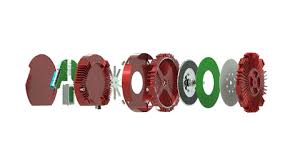Aircore Mobility’s press release from the Consumer Electronics Show (CES) in Las Vegas headlines, “Sustainable, air core, axial flux, liquid cooled e-mobility motor achieves superior power density and efficiency to extend vehicle range for applications that drive, fly or sail”
The company promotes its efficiency, high current density, and economy of manufacturing as prime factors in its success. The printed circuit board (PCB) stator is claimed to be 10 times more reliable than a conventional stator, smaller, and lighter. By replacing the iron core of a conventional motor with a PCB stator, “Mechanical losses are reduced, efficiency is increased and noise and vibration are significantly reduced.”
Several stator/rotor combinations can be “stacked” with a single housing to allow greater power outputs.
Cooling is an important element in the motor. Aircore uses a liquid cooling technique, “That allows the coolant to be in direct contact with the stator, mitigating heat across a larger surface area, enabling high overload capability and extended life.” Aircore’s approach provides a claimed 56 Amps per square millimeter, higher than many other designs.
Paulo Guedes-Pinto, vice president of technology for Infinitum, explains that the motor’s “unique PCB stator design” enables up to four to five times the current density of a conventional liquid-cooled motor and allows a broad range of loads and operating speeds with high efficiency.
Slated for service in class 1-to-8 trucks, nautical and aerial vehicles, and a variety of heavy industrial haulers. A typical class 4 to-6 truck engine would produce 150 kilowatts (201 horsepower) continuously, and 300 peak or 402 hp. With 190 Newton-meters (140 foot-pounds) of torque on tap, the motor seems like less of a puller than an International CV series Diesel with 700 ft.-lbs. even though horsepower ratings are in the same category. Perhaps gearing can help overcome that.
Although the video depicts an industrial motor, the configuration of al Aircore motors is similar.
The company notes the “active mass” for this motor is 20 kilograms (44 pounds). One wonders what the total mass is to obtain a meaningful output-to-mass ratio.
The simplicity of the Aircore motor allows it to be manufactured with simple tooling, with the housing, rotors, and stators able to be re-used several times. Sam Abuelsamid, principal analyst for Guidehouse Insights, explains,. “With supply chain challenges, the motor’s materials, rapid assembly and scalable production should also be attractive to automotive OEMs seeking dramatically simpler manufacturing going forward.”
Aircore shows innovative approaches to the motor’s manufacture, and especially their cooling system. Let’s see where this approach leads.

